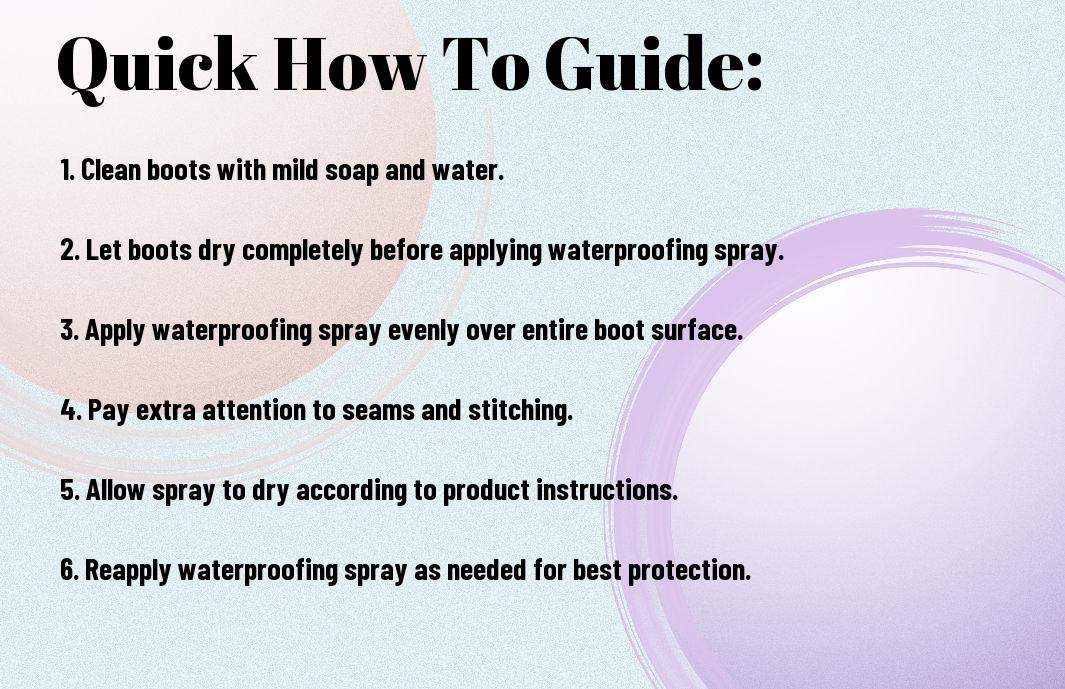Hiking in wet conditions can quickly ruin your hiking boots and make for an uncomfortable trek. In this guide, you will learn how to properly waterproof your hiking boots to ensure they stay dry and reliable on your outdoor adventures. By following these simple steps, you can protect your feet and prolong the life of your beloved hiking boots, so you can continue exploring the great outdoors with confidence.

Understanding the Importance of Waterproofing
Why Waterproofing is Crucial for Hiking Boots
To ensure that your hiking boots remain reliable and comfortable on your outdoor adventures, waterproofing them is important. When you’re out on the trails, you never know when you might encounter unexpected rain showers, puddles, or streams. Waterproofing your boots can prevent water from seeping in and keep your feet dry and warm, reducing the risk of blisters and discomfort.
Consequences of Not Waterproofing Your Boots
Forgetting to waterproof your hiking boots can have serious consequences on your hiking experience. As you traverse wet and muddy terrain without waterproofing, moisture will seep into your boots, making them heavy and uncomfortable. Wet feet are not only unpleasant, but they also increase the likelihood of developing blisters, hot spots, and other foot-related issues. This could cut your hike short and ruin your outdoor excursion.
Your hiking boots are an investment in your comfort and safety while exploring the great outdoors. Neglecting to waterproof them can significantly shorten their lifespan and compromise their performance. Moisture can cause the materials of your boots to break down more quickly, leading to decreased durability and support. Regularly waterproofing your boots will help prolong their longevity and ensure they remain a reliable companion on your hiking adventures.
Factors to Consider Before Waterproofing
While waterproofing your hiking boots is vital for keeping your feet dry and comfortable on the trail, there are a few factors you should consider before exploring into the process. By taking these factors into account, you can ensure that you choose the right waterproofing method for your specific hiking boots.
Type of Hiking Boot Material
To determine the best waterproofing method for your hiking boots, you first need to consider the material they are made of. Different materials require different waterproofing treatments, so it’s important to know what your boots are made of before you start. Leather boots, for example, may need a different waterproofing treatment than synthetic boots.
After identifying the material of your boots, you can then choose the appropriate waterproofing product that is designed specifically for that material. This will help ensure that your boots are effectively waterproofed and protected against moisture.
Boot Age and Condition
Condition: It’s crucial to assess the current condition of your hiking boots before waterproofing them. If your boots are old or worn out, waterproofing may not be enough to restore their ability to repel water. Inspect the seams, soles, and overall integrity of the boots to determine if they are in good enough condition to be waterproofed.
A: Additionally, if your boots have any existing damage or are excessively worn, it may be worth considering investing in a new pair of hiking boots rather than attempting to waterproof them. Waterproofing can help extend the life of your boots, but it is not a cure-all for boots that are past their prime.
Intended Use and Environment
Boot: Consider where and how you will be using your hiking boots when deciding on a waterproofing method. If you primarily hike in wet or snowy conditions, you may need a more heavy-duty waterproofing treatment. On the other hand, if you only hike in dry conditions occasionally, a lighter waterproofing spray may be sufficient.
It: Furthermore, if you frequently hike in rugged terrain or through streams and puddles, you will want to choose a waterproofing method that offers long-lasting protection against water. However, if you mostly stick to well-maintained trails in dry climates, a less heavy-duty waterproofing treatment may suffice.
How to Prepare Your Boots for Waterproofing
Cleaning and Drying Your Boots
For the best waterproofing results, it’s important to start with clean and dry boots. Begin by removing excess dirt and mud from your boots using a soft brush or damp cloth. Once the surface is clean, allow your boots to air dry completely before moving on to the waterproofing step. If your boots are wet, stuff them with newspaper and let them dry naturally away from direct heat sources to prevent any damage.
Removing Old Waterproofing Treatments
Boots that have been previously treated with waterproofing products may need to have the old treatments removed before applying a new one. You can use a specialized cleaner to remove old waterproofing treatments from your boots. Follow the manufacturer’s instructions carefully to ensure thorough removal of the old product, as any residue left behind can affect the performance of the new waterproofing treatment.
Understanding the type of material your boots are made of is crucial when removing old waterproofing treatments. Different materials may require different cleaning methods to effectively remove the old treatments without causing any damage to the boots.
Inspecting for Damage and Repairing
If your boots have any visible signs of damage, such as worn out soles, loose seams, or cracks in the leather, it’s important to address these issues before waterproofing. Inspect your boots thoroughly for any damage and make any necessary repairs to ensure they are in good condition before proceeding with the waterproofing process. This will not only help maintain the integrity of your boots but also ensure that the waterproofing treatment is effective.
Choosing the Right Waterproofing Method
To ensure that your hiking boots are adequately waterproofed, you need to choose the right waterproofing method. There are several options available, each with its own advantages and limitations. Take the time to consider the following factors before making a decision.
Types of Waterproofing Treatments Available
Now, let’s look at the different types of waterproofing treatments that you can consider for your hiking boots. Here is a breakdown in a table with two columns and five rows, which will help you understand the options better:
| Treatment Type | Description |
|---|---|
| Silicone-Based Sprays | Repels water effectively but can affect breathability. |
| Wax-Based Products | Provides a durable waterproof layer but may darken leather. |
| Waterproofing Creams | Good for maintaining leather boots, but may require frequent reapplication. |
| Nikwax | Environmentally friendly option that restores water repellency. |
| Gore-Tex Treatment | Specifically designed for Gore-Tex boots to maintain their waterproofing. |
Recognizing the characteristics of each type of treatment will help you choose the most suitable option for your hiking boots.
Factors to Consider When Selecting a Treatment
Now, consider these factors when selecting a waterproofing treatment for your hiking boots:
- The material of your boots
- The level of waterproofing required
- The frequency of reapplication
- Your typical hiking conditions
- Your personal preferences
Assume that considering these factors will guide you towards the most appropriate waterproofing treatment for your needs.
DIY vs. Professional Waterproofing
To decide between DIY and professional waterproofing, you should consider your expertise, time availability, and the importance of the boots. DIY waterproofing can be a cost-effective option if you have the right materials and skills. However, professional waterproofing services may provide a more thorough and long-lasting solution if you prefer a hands-off approach.
Plus, if you decide to do it yourself, make sure you follow the manufacturer’s instructions carefully to avoid damaging your hiking boots.
Applying Waterproofing Treatments
Once again, it’s time to tackle the task of waterproofing your hiking boots. Applying waterproofing treatments is a crucial step to ensure your boots remain dry and protected during your outdoor adventures. Whether you prefer wax, spray, or cream treatments, the process is relatively straightforward but requires attention to detail for best results.
Step-by-Step Guide to Applying Treatments
| Step 1: Clean your boots thoroughly | Step 2: Apply the waterproofing treatment evenly |
| Step 3: Allow the treatment to dry completely | Step 4: Reapply the treatment as needed |
Tips for Even Application and Avoiding Errors
While applying the waterproofing treatment, make sure to work in a well-ventilated area to avoid inhaling fumes. Use a clean cloth or brush to evenly distribute the treatment on your boots, focusing on seams and stitching for maximum protection. Avoid over-saturation, as excess product can affect the breathability of your boots and may cause discoloration or stiffness.
- Apply the treatment in thin layers for better absorption
- Avoid applying too much product to prevent buildup and potential damage
- Recognizing early signs of wear and tear can help you address any waterproofing issues promptly
Allowing the Treatment to Dry and Cure
To ensure the effectiveness of the waterproofing treatment, it’s imperative to allow it enough time to dry and cure properly. Depending on the type of product used, drying times may vary, so refer to the manufacturer’s instructions for guidance. Avoid rushing the process by exposing your boots to direct heat sources like heaters or sunlight, as this can damage the material and compromise the waterproofing properties.
Errors can occur if the treatment is not given adequate time to dry and cure, leading to uneven protection and potential product failure. Taking the time to allow the treatment to set properly will prolong the lifespan of your boots and keep your feet dry and comfortable on the trails.
Additional Tips for Maintaining Waterproofing
After applying waterproofing treatment to your hiking boots, there are several additional tips you can follow to ensure they stay protected from water and maintain their effectiveness. Here are some handy tips to help you upkeep the waterproofing of your boots:
Regular Maintenance and Inspection
Even after waterproofing your boots, it is important to regularly inspect them for any signs of wear and tear. Look out for scuffs, scratches, and areas where the waterproofing may have worn off. By catching these issues early, you can address them before they become bigger problems.
Any time you notice a decrease in the water resistance of your boots, make sure to reapply a waterproofing treatment. This proactive measure will help to maintain the effectiveness of the waterproofing and keep your feet dry on your hikes.
Storage and Handling Techniques
For proper storage of your waterproof hiking boots, make sure they are clean and dry before putting them away. Avoid storing them in damp or humid areas, as this can lead to mold and mildew growth on your boots.
Storage in a cool, dry place away from direct sunlight is ideal for maintaining the waterproofing treatment on your boots. Additionally, stuffing your boots with newspaper or boot trees can help them maintain their shape and prevent them from developing creases.
Extending the Life of Your Waterproofing Treatment
Life The frequency at which you use your hiking boots will determine how often you need to reapply a waterproofing treatment. If you are a frequent hiker, you may need to apply the treatment more frequently than someone who hikes occasionally.
Maintenance To extend the life of your waterproofing treatment, avoid exposing your boots to harsh chemicals or cleaners that can break down the waterproofing agents. Additionally, always follow the manufacturer’s instructions when applying a new waterproofing treatment to ensure maximum effectiveness.
Conclusion
To wrap up, waterproofing your hiking boots is vital to keep your feet dry and comfortable during your outdoor adventures. By following these simple steps, you can protect your boots from moisture and extend their lifespan. Remember to regularly maintain the waterproofing treatment to ensure continued protection.
Whether you are exploring wet, muddy trails or trekking through streams and rivers, waterproof hiking boots are a must-have for any outdoor enthusiast. By investing time in properly waterproofing your boots, you can focus on enjoying your hiking experience without having to worry about damp or wet feet. So, before your next hike, make sure to waterproof your boots and gear up for an enjoyable and comfortable adventure!
